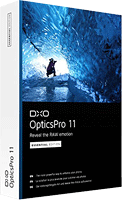DxO Optics Pro 11 makes PRIME denoising better and *much* faster; user interface improves, too
posted Friday, June 3, 2016 at 9:59 AM EDT

If you're a fan of DxO Labs' Optics Pro raw processing app for its incredible PRIME denoising engine, you're not alone. I've been heaping praise upon the feature for a fair while now, ever since it launched with Optics Pro 9 back in late 2013. This week, the launch of Optics Pro 11 sees the feature becoming even more useful as it continues to mature.
The ability of Optics Pro 9 or newer to clean up noise in high-sensitivity photos is unrivaled, but as I've mentioned before, it does come at a significant cost in terms of processing time. If you have a large batch of high-res, high ISO images to process, the PRIME engine can potentially take many hours to work its way through them all, with each photo taking perhaps one to five minutes to clean up on a reasonably powerful machine.

The PRIME denoising engine is much faster
DxO Optics Pro 11's updated PRIME engine, though, performs significantly better than past versions, both in terms of speed and image quality. DxO says that it can provide up to four times greater performance, with high ISO imagery in particular showing a great improvement in speed. In my own informal testing, I've not seen quite that much of a boost, but have found it fairly consistently to work around 50-60% faster than the previous Optics Pro 10 release.
Image quality is much better in bokeh and transitions, too
And while the improvement in terms of image quality varies quite a bit with subject matter, this too can be very noticeable indeed when pixel peeping at 1:1 onscreen with the right combination of camera, subject and sensitivity. The results are noticeably more natural-looking in the bokeh in particular, just as DxO has promised in its announcement of Optics Pro 11.






DxO's claims of better denoising held true in my own testing
For a side-by-side comparison, I ran the full image shown at the top of this article -- shot last Halloween with the Panasonic G7 at ISO 25,600-equivalent -- through both Optics Pro 10 and 11 using the DxO Standard preset, and switching to PRIME denoising at its Auto strength. Both passes at the image were on my HP ZBook 15 DreamColor laptop running Windows 7 Pro, and where Optics Pro 10 took 67 seconds to process the full image, Optics Pro 11 managed it in just 31 seconds. As you can see in the crops that follow the full image, despite the more-than-doubling of speed, the Optics Pro 11 version of the image retains the same detail and low noise levels of that from Optics Pro 10, but with cleaner results in out-of-focus areas and across tonal transitions.
A fair few more worthwhile changes, as well
The improved PRIME engine isn't the only change in DxO Optics Pro 11, but it's certainly the big news for me and anyone else who is a fan of available-light shooting. Other new or tweaked features in the new release include more intelligent tone mapping which now uses face detection to identify your subjects, automatic red-eye correction and microcontrast adjustment, and better midtone control with the selective tone function. Sliders are also more responsive in the new release, there's a new full-screen display mode, and keyboard shortcuts have been added for rating and filtering.
Pricing and availability
Available immediately, DxO Optics Pro 11 is a free upgrade for anyone who purchased version 10 on or after April 1st, 2016. Customers who purchased before that date can find upgrade pricing in the My Account section of DxO's site, and new customers can buy Optics Pro on either Mac or Windows platforms for around US$130-200 depending on version. From now through June 30th, a significant discount is available on this pricing, with DxO Optics Pro Essential Edition available for around US$100, and Elite Edition for about US$150.
More details can be found on DxO's site.